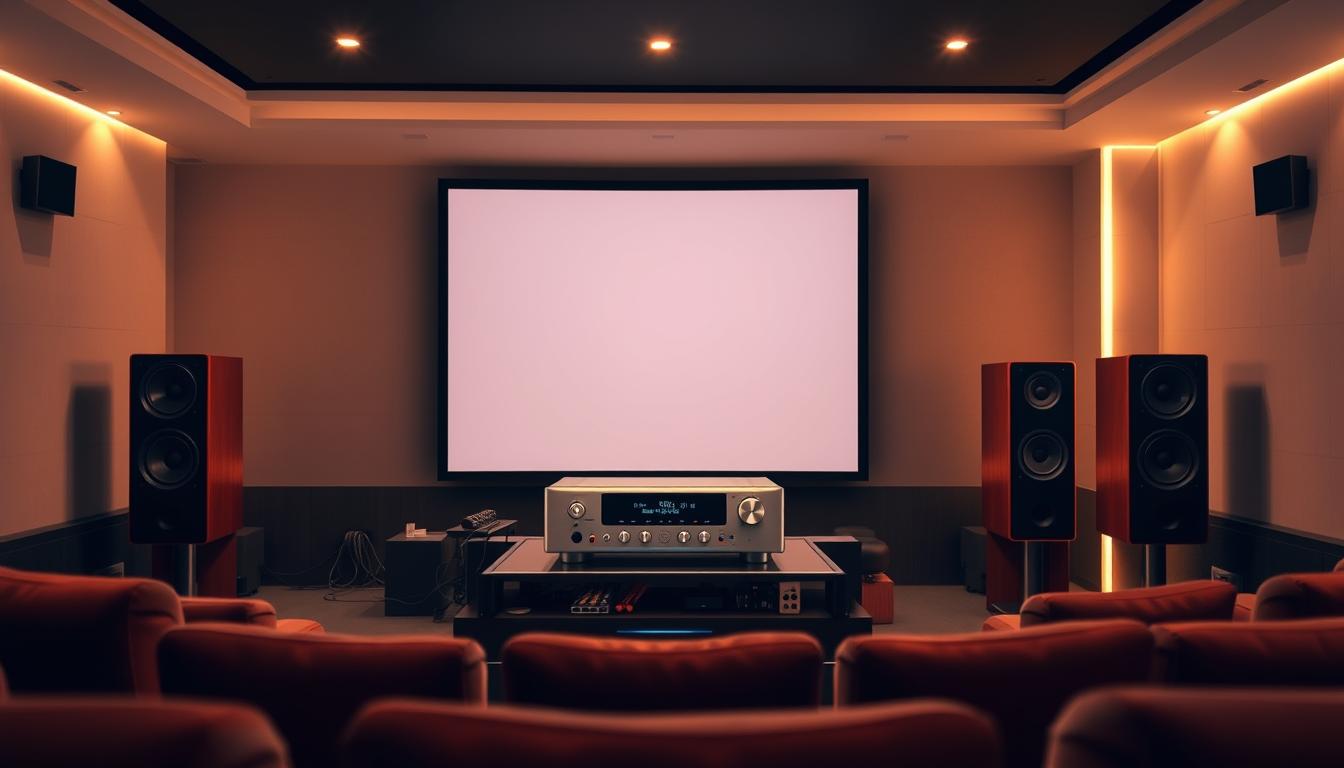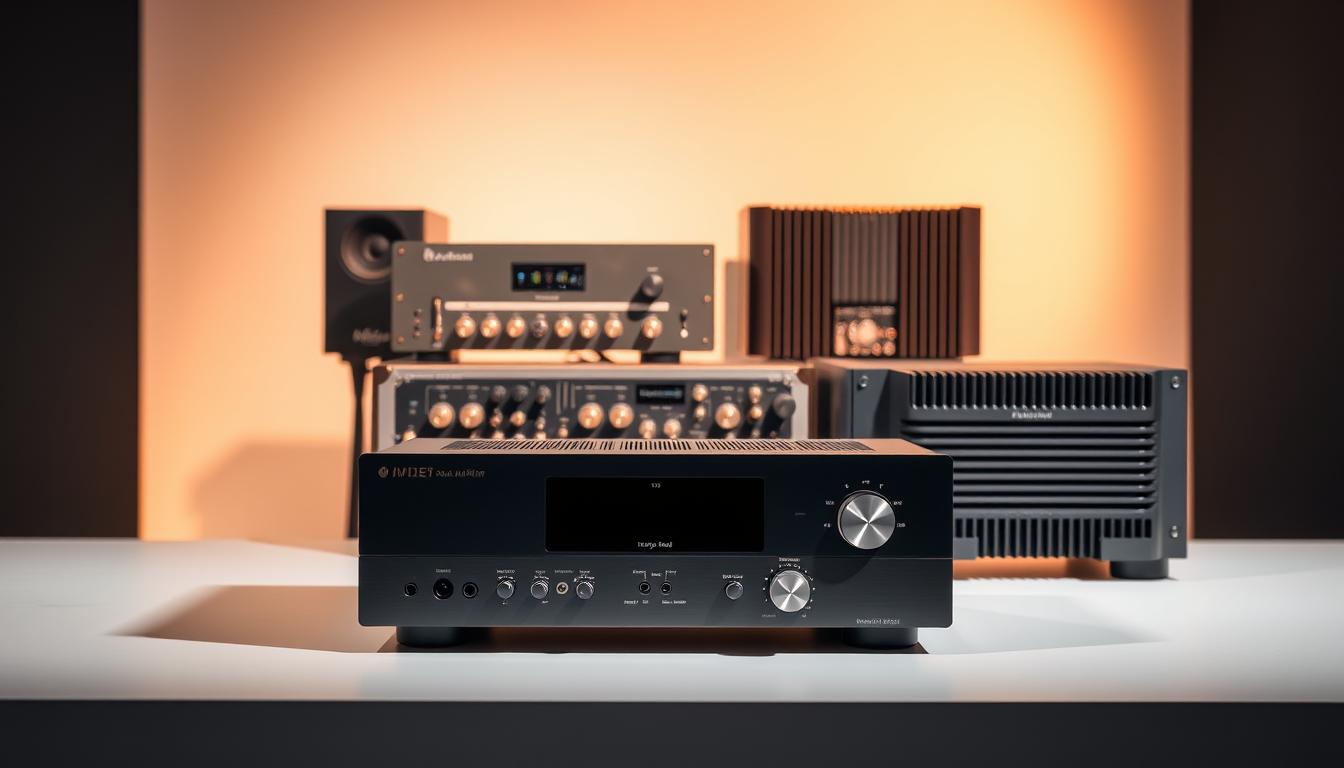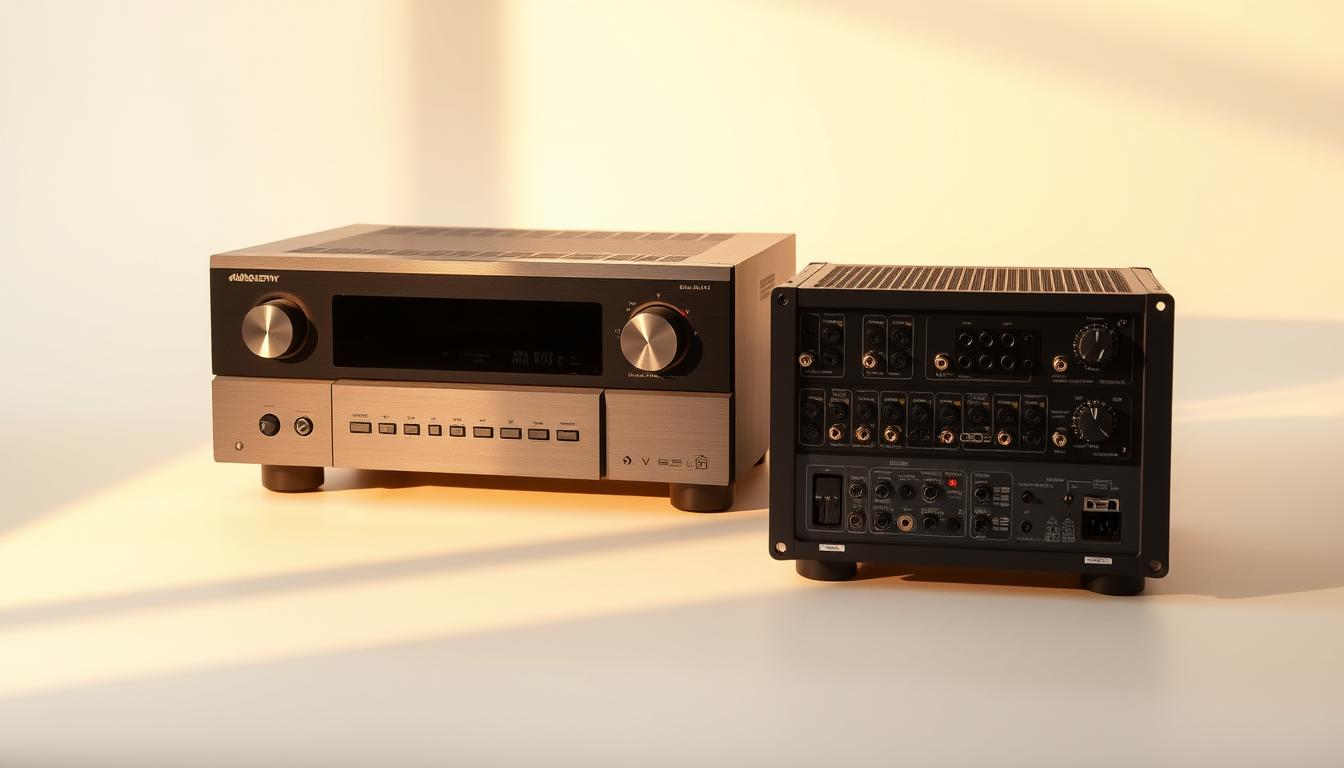Did you know that 90% of home theater enthusiasts consider their amplifier the backbone of their setup? Without it, even the best speakers fall flat. An amplifier takes low-voltage signals and boosts them, delivering crisp, powerful audio to your speakers. This ensures every explosion, whisper, and musical note comes alive in your home.
Modern systems often integrate amplifiers into compact units, offering high performance without taking up much space. Standalone amplifiers and receivers both play a critical role. While amplifiers focus solely on boosting sound, receivers combine amplification with additional features like tuners and HDMI connectivity.
Choosing the right amplifier can transform your home theater experience. It ensures balanced sound and superior audio output, whether you’re watching movies or listening to music. This guide will walk you through technical details and practical tips to help you build the perfect system.
Key Takeaways
- Amplifiers boost low-voltage signals to drive speakers effectively.
- Modern systems often integrate amplifiers into compact, high-performance units.
- Standalone amplifiers focus solely on sound, while receivers offer additional features.
- Proper amplifier selection enhances home theater audio quality.
- Understanding component roles is key to building a balanced sound system.
Understanding Audio Amplifiers
Ever wondered how your home theater delivers such powerful sound? The answer lies in its amplifier. This device takes weak signals from your source and boosts them, ensuring your speakers produce clear, dynamic audio. Understanding its components and how they work can help you optimize your setup.

Defining Amplifier Components
An amplifier consists of two main parts: the preamp and the power stage. The preamp collects signals from various inputs, such as your DVD player or turntable. It conditions these signals, preparing them for amplification. The power stage then boosts the signal, delivering enough power to drive your speakers.
Here’s a breakdown of their roles:
| Component | Function |
|---|---|
| Preamp | Collects and conditions signals from sources. |
| Power Stage | Boosts the signal to drive speakers effectively. |
How Amplifiers Work in Home Theater Setups
In a home theater system, the amplifier plays a central role. It takes low-level signals from your source, processes them through the preamp, and amplifies them to power your speakers. This ensures every sound, from whispers to explosions, is delivered with clarity and precision.
Proper component selection is crucial. A high-quality preamp can significantly enhance signal clarity, while a robust power stage ensures your speakers perform at their best. Even small improvements in the preamp stage can elevate your system’s overall performance.
Enhancing Your Home Theater with Amplification
What if your home theater could deliver even more immersive audio with the right amplifier? Amplification is the secret to unlocking the full potential of your system. It ensures every sound, from subtle whispers to explosive effects, is crisp and powerful.

Signal Processing and Audio Boost
Amplifiers excel at signal processing, refining audio for better clarity. They take low-level signals and enhance them, ensuring your speakers produce rich, detailed sound. This process eliminates distortion, delivering a cleaner output.
Dedicated amplifiers often outperform multi-function receivers. They focus solely on amplification, providing a more robust audio boost. This results in a more immersive home theater experience.
Power and Performance Metrics
Power output is a critical factor in amplifier performance. Measured in watts, it determines how effectively your speakers can reproduce sound. Higher wattage ensures louder, distortion-free audio, even at peak volumes.
Here are key metrics to consider:
- Wattage: Higher ratings mean more power for your speakers.
- Total Harmonic Distortion (THD): Lower values indicate cleaner sound.
- Signal-to-Noise Ratio (SNR): Higher ratios ensure minimal background noise.
Matching amplifier power to your home theater requirements is essential. It ensures optimal performance and prevents underpowered or distorted audio. With the right setup, your system will deliver exceptional sound quality for movies, music, and more.
The Role of Audio Amplifiers in Surround Sound Systems
Choosing the right setup for your home theater can make all the difference in sound quality. Whether you opt for an integrated amplifier or separate components, each approach has its unique advantages. Understanding these options helps you build a system that meets your needs.

Integrated Solutions Versus Separate Components
An integrated amplifier combines the preamp and power stage into a single unit. This design simplifies setup and saves space, making it ideal for smaller rooms. Integrated solutions are built for convenience and often deliver excellent performance for most users.
Separate components, on the other hand, offer dedicated performance. A standalone preamp and power amplifier can reduce noise interference by up to 15%. This setup is preferred by audiophiles who prioritize sound clarity and flexibility.
Here’s a quick comparison:
- Integrated Amplifier: Compact, easy to set up, and cost-effective.
- Separate Components: Superior sound quality, reduced noise, and customizable.
Optimizing Your Speaker Signal Path
Your signal path plays a crucial role in audio quality. Proper cable management ensures a clean, strong connection between components. High-quality cables minimize interference and deliver the best possible sound.
Every component in your system contributes to the overall performance. From the receiver to the speakers, each part must work seamlessly. For example, matching preamplifiers and receivers can significantly enhance sound quality.
Here are some tips to optimize your setup:
- Use shielded cables to reduce electromagnetic interference.
- Ensure all connections are secure and free from corrosion.
- Position components to minimize cable length and signal loss.
By focusing on these details, you can create a sound system that delivers exceptional audio for movies, music, and more.
Types of Amplifiers: Integrated, Preamp, and Power Amplifier
Understanding the different types of amplifiers can help you make the best choice for your sound system. Each type serves a unique purpose, from managing signals to delivering the necessary power for your speakers. Let’s break down the key differences and benefits of integrated amplifiers, preamps, and power amplifiers.

Pre-amplifier Functions and Signal Management
A preamp is essential for managing and conditioning audio signals. It collects input from various sources, such as your turntable or CD player, and prepares the signal for amplification. This process includes tone control and volume adjustment, ensuring the signal is clean and ready for the next stage.
Key functions of a preamp include:
- Source selection: Choose between multiple audio inputs.
- Signal conditioning: Refine the audio for clarity and balance.
- Tone control: Adjust bass, treble, and midrange frequencies.
Power Amplifier: Delivering the Necessary Wattage
The power amplifier takes the conditioned signal from the preamp and boosts it to drive your speakers. Measured in watts, its output determines how loud and clear your audio will be. Higher wattage ensures distortion-free sound, even at peak volumes.
Here’s how a power amplifier enhances your system:
- Delivers sufficient wattage to drive speakers effectively.
- Ensures dynamic and powerful audio output.
- Reduces distortion for cleaner sound quality.
Integrated Amplifiers Versus Separate Components
An integrated amplifier combines the preamp and power amplifier into a single unit. This design is compact and cost-effective, making it ideal for smaller setups. Some models even include a built-in tuner for added convenience.
Separate components, like standalone preamps and power amplifiers, offer superior performance. They reduce noise interference and provide greater flexibility for customization. This setup is preferred by audiophiles who prioritize sound quality.
| Type | Advantages |
|---|---|
| Integrated Amplifier | Compact, easy to set up, and cost-effective. |
| Separate Components | Superior sound quality, reduced noise, and customizable. |
Whether you choose an integrated solution or separate components depends on your needs. For a simple setup, an integrated amplifier is a great choice. For those seeking the best sound quality, separate preamps and power amplifiers are the way to go.
Choosing the Right Amplifier for Your Home Audio
Finding the perfect amplifier for your home audio setup can elevate your listening experience to new heights. The right choice ensures your system delivers clear, powerful sound tailored to your space and preferences. Let’s explore how to match amplifier specifications with your room acoustics and budget requirements.

Assessing Your Room and Speaker Specifications
Your room dimensions and acoustics play a critical role in amplifier performance. Larger spaces may require higher wattage to fill the area with sound, while smaller rooms benefit from compact, efficient setups. Consider factors like wall materials and furniture placement, as they can affect sound quality.
Next, evaluate your speaker specifications. Check the power rating and impedance to ensure compatibility with your amplifier. For example, speakers with an 8-ohm impedance and a power range of 75-300 watts pair well with most amplifiers. Matching these details prevents underpowered or distorted audio.
Balancing Budget with High-Quality Output
Budget is a key factor in choosing the right amplifier. While high-end models offer superior performance, mid-range options can still deliver excellent sound quality. Focus on features like Total Harmonic Distortion (THD) and Signal-to-Noise Ratio (SNR) to ensure clean, dynamic audio within your price range.
Here are some practical tips for optimizing your setup:
- Measure your room and choose an amplifier with sufficient wattage.
- Match amplifier specifications to your speaker requirements.
- Invest in shielded cables to minimize interference and signal loss.
By carefully assessing your space and speaker needs, you can create a tailored audio experience that meets your expectations. Whether you’re upgrading an existing system or starting from scratch, the right amplifier makes all the difference.
Integration vs. Receiver: Which Option Is Best for You?
Deciding between a receiver and a standalone amplifier can shape your audio experience. Each option offers unique benefits, depending on your needs. Receivers combine multiple features, while standalone amplifiers focus solely on delivering superior sound quality.

Comparing Receivers to Standalone Amplifiers
Receivers are multi-functional devices that integrate amplification with additional features like built-in tuners and video inputs. They are ideal for users who want an all-in-one solution. For example, the Denon AVR-X3800H includes room correction technology, enhancing both audio and video performance.
Standalone amplifiers, on the other hand, prioritize amplifier power and sound clarity. They excel in delivering consistent performance, even when driving multiple channels. This makes them a favorite among audiophiles who value precision over convenience.
Here’s a quick comparison:
| Feature | Receiver | Standalone Amplifier |
|---|---|---|
| Functionality | Multi-functional with built-in tuners and video inputs. | Dedicated to amplification for superior sound quality. |
| Performance | Versatile but may compromise on amplifier power. | Consistent and powerful audio output. |
| Cost | Affordable entry-level options starting at $350. | Higher cost for premium performance. |
When to Consider a Receiver for Radio and More
Receivers are a great choice if you enjoy listening to FM/DAB radio or need built-in streaming capabilities. They also simplify setups by combining audio and video processing in one unit. For example, the AXR100D offers FM/DAB+ functionality, making it a versatile option for diverse needs.
If you’re building a home theater, a receiver can drive multiple speakers, including a subwoofer, for an immersive movie experience. However, for critical listening or high-end setups, pairing a receiver with a dedicated amplifier can offer the best of both worlds.
Here are some scenarios where a receiver shines:
- You need an all-in-one solution for audio and video.
- FM/DAB radio or streaming is a priority.
- Your setup includes a subwoofer and multiple speakers.
Ultimately, your choice depends on your priorities. For convenience and versatility, a receiver is hard to beat. For unmatched sound quality, a standalone amplifier is the way to go.
Optimizing Your Amplifier Setup for Exceptional Surround Sound
Achieving flawless surround sound starts with optimizing your amplifier setup. Proper placement, cable management, and calibration ensure every channel delivers balanced, immersive audio. Let’s dive into expert tips to elevate your system’s performance.
Ideal Placement and Cable Management
Place your amplifier in a well-ventilated area to prevent overheating. Keep it close to your speakers to minimize cable length and signal loss. Position speakers at ear level when seated for optimal sound projection.
Use shielded cables to reduce electromagnetic interference. Avoid placing speakers in corners or against walls, as this can cause bass resonance. Soft furnishings like rugs and curtains can absorb excess sound, improving clarity.
Fine-tuning Channels and Signal Integrity
Calibrate each channel individually to ensure balanced audio. Use a sound meter or your receiver’s built-in calibration tool to adjust levels. This ensures consistent sound across all speakers.
Adjust your preamplifier settings for clear, noise-free output. Ensure all connections are secure and free from corrosion. Regularly check for software updates to maintain peak performance.
Here’s a quick checklist for optimizing your setup:
- Position speakers at ear level and equidistant from the listening area.
- Use high-quality, shielded cables to minimize interference.
- Calibrate each channel for balanced sound.
- Adjust preamplifier settings for clarity and minimal noise.
- Perform regular maintenance to ensure optimal performance.
By following these steps, you can create a surround sound system that delivers exceptional audio for movies, music, and more. Proper optimization ensures every input and channel works seamlessly, providing an immersive listening experience.
Conclusion
Your home theater’s performance hinges on the right amplifier choice. Whether you’re enjoying music or movies, a dedicated amplifier ensures clear, powerful sound. Matching power and compatibility to your setup is crucial for optimal performance.
Integrated solutions offer convenience, while separate components deliver superior sound quality. Modern features like Dolby Atmos enhance immersion, making your theater system feel alive. Built-in tuners and streaming options add versatility to your setup.
When selecting an amplifier, consider your room size, speaker specifications, and budget. High-quality components minimize distortion and maximize clarity. For expert guidance, consult professionals to find the best option for your needs.
Transform your home theater experience by investing in the right amplifier. Explore key features like connectivity and signal integrity to elevate your setup. Learn more about optimizing your home theater preamplifier for unmatched audio performance.
FAQ
What is the role of an amplifier in a home theater system?
An amplifier boosts the audio signal from your source to power your speakers, ensuring clear, high-quality sound for movies, music, and more.
How does an amplifier improve surround sound performance?
Amplifiers enhance surround sound by delivering precise power to each channel, creating an immersive audio experience with balanced dynamics.
What’s the difference between an integrated amplifier and a power amplifier?
An integrated amplifier combines a preamp and power amp in one unit, while a power amplifier focuses solely on boosting the signal to drive speakers.
Should I choose a receiver or a standalone amplifier for my setup?
A receiver is ideal if you need built-in features like radio tuners and streaming capabilities, while a standalone amplifier offers superior audio performance for dedicated setups.
How do I choose the right amplifier for my speakers?
Match the amplifier’s power output to your speaker’s specifications and consider your room size to ensure optimal performance and sound quality.
Can I use an amplifier with Dolby Atmos systems?
Yes, amplifiers compatible with Dolby Atmos can enhance the spatial audio experience by powering ceiling or height speakers effectively.
What’s the importance of signal processing in amplifiers?
Signal processing ensures the audio signal remains clean and accurate, reducing distortion and improving overall sound clarity.
How do I optimize my amplifier setup for the best sound?
Proper placement, cable management, and fine-tuning channel levels are key to achieving exceptional surround sound performance.
Is a preamp necessary for my home audio system?
A preamp is essential if you need to manage multiple audio sources or require precise control over volume and tone adjustments.
What should I consider when balancing budget and quality in an amplifier?
Focus on amplifiers that offer high-quality output within your budget, ensuring compatibility with your speakers and room size for the best value.


